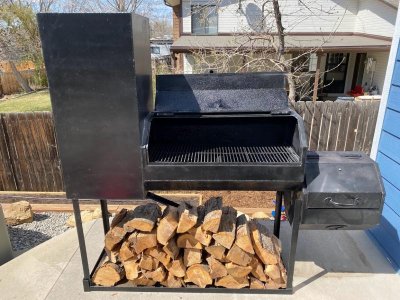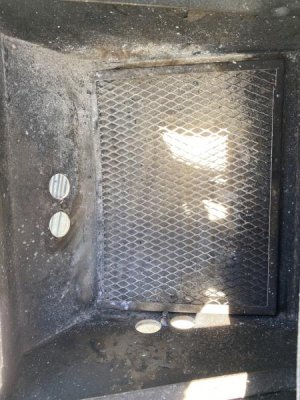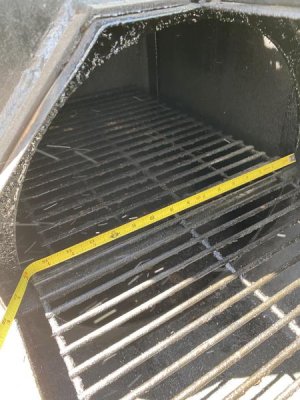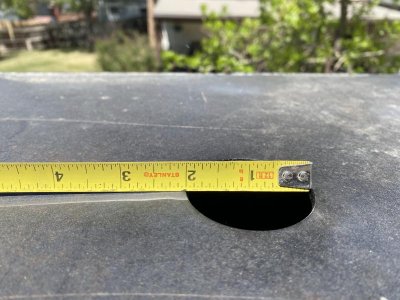lackskill
Well-known member
After years of agonizing over buying an offset and coming close on a couple occasions, I finally bought my first pit a couple weeks ago. It's very much a home built unit, and I'm the 3rd owner. It's not my ideal pit, but the price was right and so was the availability. The previous owner had it for about 10 years and had success with it.
I initially did a biscuit test just to get a feel for it. The temperatures across the pit were uneven but predictable; cooler as you move away from the fire, and substantially more even after you move the first 6" away from the firebox. Managed a clean fire for about 2 hours without much drama. Getting it to start drawing required opening the door on the vertical box.
The second time I ran it, I did some drums and thighs. Starting it was the same. No draft until I ran it with the vertical door open for about 15 minutes. No big deal. I had a little more trouble getting temperatures to settle in this time, it didn't want to keep drawing, so I had to open the vertical door a couple more times. Fire was clean and I was running 2-4 splits of seasoned apple most of the time, varying size and quantity to understand the effects. Wind was higher and from a different direction for this run. In the beginning it was 2-3 mph with the occasional 5-7 mph gust. That was no problem. At about the 2 hour mark, it became clear to me that my cook temperature was substantially lower than the pit temperature measured on the thermometer in the door, so I moved all the food a little closer to the fire and added a split. About 10 minutes later, the wind kicked up to 10-30 and almost immediately I lost all draft and couldn't get pit temps above 200 on the door thermometer, which was about 130 at the food. I fought it for about an hour trying everything from adding splits to opening doors, keeping doors cracked, etc. During this time when I would open the vertical door, the wind direction would cause it to push all the heat back out of the firebox. The fire stayed hot and clean the whole time, but I couldn't get any heat into the pit.
I suspect that what happened is the wind crossing the top of the vertical box caused airflow to stop, and also the wind hitting the pit caused the surface temperature to drop, both causing the draft to stall. There is no chimney, just the vertical box which has a 2" hole centered on top for an exit.
I'm hoping someone can confirm my thoughts here, but I think what I need to do is enlarge the hole and possibly add a chimney. I'm guessing, looking at the previous owners house, that he had an area that was very shielded from the wind. This isn't an option for me, so I either have to find a way to resolve the design deficiency of this pit or, as a last resort, sell it. I really don't want to sell it and I'm willing to tinker, but I don't want to ruin $80 briskets and I'm really chomping at the bit for good brisket.
I initially did a biscuit test just to get a feel for it. The temperatures across the pit were uneven but predictable; cooler as you move away from the fire, and substantially more even after you move the first 6" away from the firebox. Managed a clean fire for about 2 hours without much drama. Getting it to start drawing required opening the door on the vertical box.
The second time I ran it, I did some drums and thighs. Starting it was the same. No draft until I ran it with the vertical door open for about 15 minutes. No big deal. I had a little more trouble getting temperatures to settle in this time, it didn't want to keep drawing, so I had to open the vertical door a couple more times. Fire was clean and I was running 2-4 splits of seasoned apple most of the time, varying size and quantity to understand the effects. Wind was higher and from a different direction for this run. In the beginning it was 2-3 mph with the occasional 5-7 mph gust. That was no problem. At about the 2 hour mark, it became clear to me that my cook temperature was substantially lower than the pit temperature measured on the thermometer in the door, so I moved all the food a little closer to the fire and added a split. About 10 minutes later, the wind kicked up to 10-30 and almost immediately I lost all draft and couldn't get pit temps above 200 on the door thermometer, which was about 130 at the food. I fought it for about an hour trying everything from adding splits to opening doors, keeping doors cracked, etc. During this time when I would open the vertical door, the wind direction would cause it to push all the heat back out of the firebox. The fire stayed hot and clean the whole time, but I couldn't get any heat into the pit.
I suspect that what happened is the wind crossing the top of the vertical box caused airflow to stop, and also the wind hitting the pit caused the surface temperature to drop, both causing the draft to stall. There is no chimney, just the vertical box which has a 2" hole centered on top for an exit.
I'm hoping someone can confirm my thoughts here, but I think what I need to do is enlarge the hole and possibly add a chimney. I'm guessing, looking at the previous owners house, that he had an area that was very shielded from the wind. This isn't an option for me, so I either have to find a way to resolve the design deficiency of this pit or, as a last resort, sell it. I really don't want to sell it and I'm willing to tinker, but I don't want to ruin $80 briskets and I'm really chomping at the bit for good brisket.









